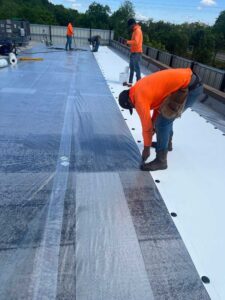
Commercial buildings in Paragould require durable and long-lasting roofing systems to protect them from various weather conditions. One popular choice for commercial roofs in this area is flat roofing. Understanding the different aspects of flat roofing systems is essential for property owners and facility managers to make informed decisions about their commercial buildings.
Understanding Flat Roofing Systems
Flat roofing systems consist of several key components that work together to provide a reliable and efficient roofing solution. These components include:
Key Components of Flat Roofs
1. Roof Deck: The roof deck is the base layer of the flat roof system. It provides structural support and serves as the foundation for the other roofing materials.
2. Insulation: Insulation plays a crucial role in regulating the temperature inside the commercial building. It helps in maintaining energy efficiency and reducing heating and cooling costs.
3. Membrane: The membrane is the waterproof layer of the flat roof that prevents water from penetrating the building. Common membrane materials include EPDM, TPO, or PVC.
4. Flashing: Flashing is used to create watertight seals at vulnerable areas, such as roof edges, corners, and penetrations. It protects against leaks and strengthens the overall roof structure.
Types of Commercial Flat Roofs
There are several types of flat roofs commonly used in commercial buildings:
- Built-Up Roof (BUR): This traditional type of flat roof consists of multiple layers of asphalt and felt. BUR roofs are known for their durability and ability to withstand heavy foot traffic.
- Modified Bitumen: Modified bitumen roofs are made of asphalt and reinforced with fiberglass or polyester. They provide excellent flexibility and are resistant to impact and puncture.
- Single-Ply Membrane: Single-ply membranes are lightweight and cost-effective options. They are available in different materials such as EPDM, TPO, or PVC and offer excellent weather resistance.
- Metal: Metal roofs are gaining popularity in commercial buildings. They are lightweight, durable, and provide superior protection against harsh weather conditions.
When it comes to choosing the right flat roofing system for your commercial building, it’s important to consider various factors such as the building’s location, climate, and budget. Each type of flat roof has its own advantages and disadvantages, so it’s crucial to consult with a professional roofing contractor who can assess your specific needs and recommend the most suitable option.
Additionally, regular maintenance and inspections are essential to ensure the longevity and performance of your flat roof. This includes clearing debris, checking for signs of damage or wear, and addressing any issues promptly to prevent further damage.
Remember, a well-designed and properly installed flat roofing system can provide reliable protection for your commercial building, ensuring the comfort and safety of its occupants while minimizing energy costs. So, invest in the right flat roof and prioritize its maintenance to enjoy long-term benefits.
Benefits of Flat Roofing for Commercial Buildings
Flat roofing systems offer numerous benefits for commercial buildings in Paragould. Some of these advantages include:
Space Utilization and Accessibility
Flat roofs provide additional usable space for various purposes, such as rooftop gardens, outdoor lounges, or equipment installations. The flat surface allows easier access for maintenance and repairs compared to sloped roofs.
Moreover, the extra space provided by flat roofs can also be utilized for solar panel installations, which can help commercial buildings in Paragould reduce their carbon footprint and energy costs. By harnessing the power of the sun, businesses can generate their electricity and contribute to a more sustainable environment.
Cost-Effectiveness and Energy Efficiency
Flat roofs are generally more cost-effective to install and maintain than sloped roofs. They require fewer materials and less labor, resulting in lower overall costs. Additionally, flat roofs can be designed with insulation materials that enhance energy efficiency, reducing heating and cooling expenses.
Furthermore, the design flexibility of flat roofing systems allows for the incorporation of green roofing technologies, such as cool roofs or vegetative roofs. Cool roofs reflect sunlight and absorb less heat, reducing the need for air conditioning and decreasing energy consumption. On the other hand, vegetative roofs not only provide insulation but also improve air quality, reduce stormwater runoff, and create a habitat for local wildlife, contributing to a healthier and more sustainable urban environment.
Common Challenges with Flat Roofs
While flat roofing systems offer numerous benefits, they also present some challenges that property owners need to address:
Drainage Issues and Water Pooling
One of the primary concerns with flat roofs is the potential for water pooling due to insufficient drainage. Standing water can cause structural damage, leaks, and even promote the growth of mold and mildew. Proper roof slope and the installation of effective drainage systems are crucial to prevent these issues.
Furthermore, inadequate drainage can lead to increased stress on the roof structure, potentially compromising its integrity over time. It is essential for property owners to regularly inspect their flat roofs to ensure that water is draining properly and not accumulating in any areas.
Maintenance and Repair Considerations
Maintaining flat roofs requires regular inspections and proactive maintenance. The lack of slope makes it easier for debris to accumulate and can lead to clogged drains or damage to the membrane. Timely repairs of any damaged areas or leaks are vital to prevent costly structural damage.
In addition to regular maintenance, property owners should also consider the quality of materials used in flat roof construction. High-quality membranes, sealants, and insulation can prolong the lifespan of the roof and reduce the frequency of repairs. Investing in durable materials upfront can save property owners significant costs in the long run.
Selecting the Right Roofing Material
Choosing the proper roofing material is essential for the long-term durability and performance of a flat roof. Consider the following factors when selecting a roofing material:
Durability and Lifespan of Materials
Invest in high-quality roofing materials with proven durability and a long lifespan. Research different options and consider factors such as weather resistance, resistance to punctures, and overall strength.
Weather Resistance and Insulation Properties
Paragould experiences a range of weather conditions throughout the year, including hot summers and cold winters. Ensure the roofing material you choose has excellent weather resistance and insulation properties to provide year-round protection.
Professional Flat Roof Installation in Paragould
Proper installation is crucial to the success and longevity of a flat roofing system. Hiring a reputable and experienced roofing contractor in Paragould is essential for a smooth and reliable installation process.
Importance of Proper Installation
A poorly installed flat roof can lead to numerous issues, including leaks, water damage, and premature deterioration. Professional installation ensures the correct placement of all components, proper sealing of seams, and adherence to local building codes and regulations.
Choosing a Reliable Roofing Contractor
When selecting a roofing contractor in Paragould, consider their experience, reputation, and track record. Look for certifications and licenses, as well as testimonials and reviews from previous clients. A reliable contractor will provide a detailed proposal, explain the installation process, and offer warranties for their work.
In conclusion, flat roofing systems are an excellent choice for commercial buildings in Paragould. Understanding the key components, types of flat roofs, and their associated benefits and challenges is crucial for property owners and facility managers. By selecting the right roofing material and working with a reputable roofing contractor, commercial building owners can ensure the longevity, durability, and performance of their flat roofs.
Ready to secure your Paragould commercial property with a top-tier flat roofing system? Look no further than Commercial Roofing Rana, where our expertise extends across Tennessee, Kentucky, Mississippi, and Arkansas. With a legacy of excellence since 1983, we specialize in Duro-Last roofing systems, ensuring a perfect fit and unmatched protection for your building. Don’t let water damage threaten your business—our licensed professionals are committed to delivering quality that safeguards your employees, customers, and assets. From industrial complexes to shopping centers, we’ve got your roofing needs covered. Schedule Now! and let Commercial Roofing Rana provide the durable, efficient roofing solution your commercial building deserves.
